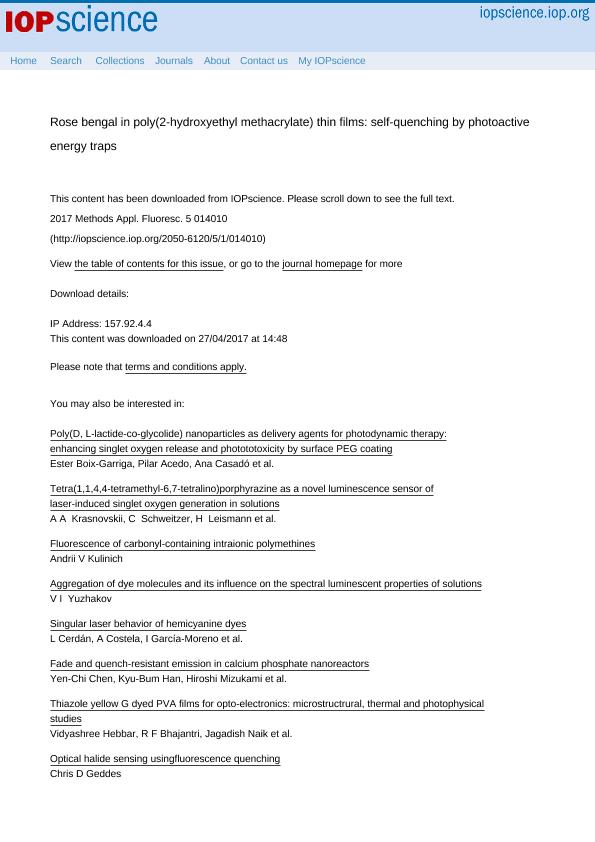Artículo
Rose bengal in poly(2-hydroxyethyl methacrylate) thin films: Selfquenching by photoactive energy traps
Fecha de publicación:
03/2017
Editorial:
IOP Publishing
Revista:
Methods and Applications in Fluorescence
ISSN:
2050-6120
Idioma:
Inglés
Tipo de recurso:
Artículo publicado
Clasificación temática:
Resumen
The effect of dye concentration on the fluorescence, ΦF, and singlet molecular oxygen, ΦΔ, quantum yields of rose bengal loaded poly(2-hydroxyethyl methacrylate) thin films (∼200 nmthick) was investigated, with the aim of understanding the effect of molecular interactions on the photophysical properties of dyes in crowded constrained environments. Films were characterized by absorption and fluorescence spectroscopy, singlet molecular oxygen (1O2) production was quantified using a chemical monitor, and the triplet decay was determined by laser flash-photolysis. For the monomeric dilute dye, ΦF=0.05±0.01 andΦΔ=0.76±0.14. The effect of humidity and the photostability of the dye were also investigated. Spectral changes in absorption and fluorescence in excess of 0.05Mand concentration self-quenching after 0.01Mare interpreted in the context of a quenching radius model. Calculations of energy migration and trapping rates were performed assuming random distribution of the dye. Best fits of fluorescence quantum yields with concentration are obtained in the whole concentration range with a quenching radius rQ=1.5 nm, in the order of molecular dimensions. Agreement is obtained only if dimeric traps are considered photoactive, with an observed fluorescence quantum yield ratio ΦF, trap/ΦF, monomer≈0.35. Fluorescent traps are capable of yielding triplet states and 1O2. Results show that the excited state generation efficiency, calculated as the product between the absorption factor and the fluorescence quantum yield, is maximized at around 0.15 M, a very high concentration for random dye distributions. Relevant information for the design of photoactive dyed coatings is provided.
Archivos asociados
Licencia
Identificadores
Colecciones
Articulos(INIFTA)
Articulos de INST.DE INV.FISICOQUIMICAS TEORICAS Y APLIC.
Articulos de INST.DE INV.FISICOQUIMICAS TEORICAS Y APLIC.
Articulos(INQUIMAE)
Articulos de INST.D/QUIM FIS D/L MATERIALES MEDIOAMB Y ENERGIA
Articulos de INST.D/QUIM FIS D/L MATERIALES MEDIOAMB Y ENERGIA
Articulos(OCA HOUSSAY)
Articulos de OFICINA DE COORDINACION ADMINISTRATIVA HOUSSAY
Articulos de OFICINA DE COORDINACION ADMINISTRATIVA HOUSSAY
Citación
Ezquerra Riega, Sergio Dario; Rodriguez, Hernan Bernardo; San Roman, Enrique Arnoldo; Rose bengal in poly(2-hydroxyethyl methacrylate) thin films: Selfquenching by photoactive energy traps; IOP Publishing; Methods and Applications in Fluorescence; 5; 1; 3-2017
Compartir
Altmétricas




